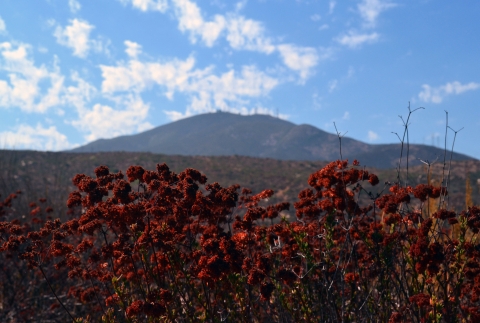Projects and Research
Listed and Sensitive Species
To better understand the refuge’s biological resources, staff conduct periodic surveys to assess the distribution and status of plants and animals, with a focus on species that are endangered, threatened, or otherwise considered sensitive or rare. The refuge provides habitat for nearly 50 such species.
Surveys may include mapping the breeding territories of the endangered least Bell’s vireos (Vireo bellii pusillus), a migratory songbird found along the Sweetwater River and its tributaries, or assessing the condition of dot-seed plantain (Plantago erecta), a low-growing plant in coastal sage scrub openings that serves as a host for larvae of the endangered Quino checkerspot butterfly (Euphydryas editha quino).
Information gathered from these surveys helps determine whether populations are increasing, decreasing, or stable. This data may trigger management actions such as controlling invasive weeds that reduce habitat quality or limiting public access to nesting areas during breeding season. Sharing survey results with other agencies and researchers supports recovery efforts across species’ ranges, with the ultimate goal of achieving healthy populations that are no longer at risk of extinction.
Habitat Restoration and Enhancement
Habitat restoration projects improve conditions for listed and sensitive species across the refuge’s diverse habitats. These efforts include:
- Controlling invasive plants in burn areas or sites disturbed by past development or agriculture.
- Removing non-native shrubs and trees from riparian riparian
Definition of riparian habitat or riparian areas.
Learn more about riparian areas to allow native vegetation to thrive. - Planting cactus in burned areas to restore habitat for cactus wrens.
- Planting and maintaining oak seedlings to replace those lost to disease, pests, or past land use.
- Installing nest boxes for burrowing owls and western bluebirds.
- Restoring vernal pools to support species associated with this rare clay soil habitat.
Habitat and Wildlife Protection
The refuge uses a variety of management strategies to minimize disturbance to wildlife and protect water quality from erosion, illegal encampments, and dumping. Staff install and maintain fencing, gates, and signs, and monitor for unauthorized activities such as off-trail use, unleashed dogs, vehicle trespass, and illegal dumping. When necessary, refuge law enforcement officers issue citations for violations.
Abandoned mine shafts are secured with wildlife-friendly gates that allow bats and other small animals to continue using them as habitat. Trails may be rerouted to reduce erosion and protect sensitive habitats and species.
Research and Surveys
The refuge supports a variety of research and resource surveys conducted by graduate students, universities, public agencies such as the United States Geological Survey (USGS) and the California Department of Fish and Wildlife (CDFW), as well as private and nonprofit organizations including the California Native Plant Society, Center for Natural Lands Management, and San Diego Natural History Museum.
All research conducted on the refuge is evaluated to ensure it aligns with refuge purposes and provides benefits to refuge management or resources. Projects by outside parties that are not directly related to refuge management may only be conducted after obtaining a Special Use Permit (SUP) issued by the Refuge Manager.
Southern Border Fuels Project
Learn more about the Southern Border Fuels Project, which focuses on removing non-native invasive plants along the Sweetwater River to improve habitat quality and reduce wildfire risk.



